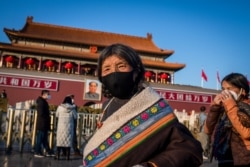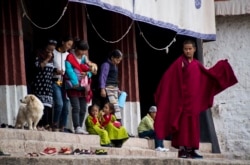On May 23, China’s state-run Xinhua news agency ran a feature commemorating the 70th anniversary of the Seventeen Point Agreement, which resulted in Tibet’s subjugation to China.
The article, headlined “Tibet makes great strides in 70 years after peaceful liberation,” claims that since 1951, “the people of Tibet have broken free from the fetters of invading imperialism for good.”
It further claims that in March 1959, “democratic reform was launched in Tibet and feudal serfdom was finally abolished.”
The claim that China peacefully liberated Tibet in 1951 is false. Much of the language in the Xinhua article mirrors that of the Seventeen Point Agreement, which actually was signed under the threat of force.
Although Tibet’s status throughout history is hotly contested, its independence between 1911 and 1951 only came to an end with an invasion by China’s People's Liberation Army in October 1950.
In Melvyn Goldstein’s "A History of Modern Tibet, volume 2: The Calm before the Storm: 1951-1955," Tibet's head delegate, Tsepon W. D. Shakabpa, was quoted as saying to China's ambassador to India the following during a September 15, 1950, meeting in New Delhi:
“[T]here is no need to liberate Tibet from imperialism, since there are no British, American or Guomindang imperialists in Tibet, and Tibet is ruled and protected by the (Buddhist leader) Dalai Lama (not any foreign power).”
According to Goldstein, China’s ambassador, Yuan Zhongxian, said that if Tibet did not accept being part of China and cede its defense, foreign and trade policies to Beijing, People’s Liberation Army (PLA) forces would “liberate” Tibet militarily.
The Tibetan government did not accept Beijing’s demands.
The following month, an estimated 40,000 Chinese troops entered Tibet, capturing the border town of Chamdo on October 19. Citing Chinese sources, S.L. Kuzmin wrote in "Hidden Tibet, History of Independence and Occupation" that 5,738 Tibetans were killed, wounded or captured in the operation to take Chamdo.
Paradoxically, China’s State Council Information Office said “the battle created the conditions for the peaceful liberation of Tibet."
In the book "The Historical Status of China's Tibet," Jiawei Wang and Gyaincain Nyima write that China rationalized its claim that it liberated Tibet, not invaded it, by arguing that a 1974 United Nations resolution defined aggression as "the use of armed force by a State against the sovereignty, territorial integrity or political independence of another State." Therefore, China therefore could not have invaded Tibet, since Beijing did not consider it to be another state.
Beijing used its 1950 military victory to push the Tibetans to the negotiating table, at which Tibet signed the so-called “Seventeen Point Agreement for the Peaceful Liberation of Tibet.”
Gyalwa Rinpoche, the 14th Dalai Lama who became the ruler of Tibet in 1950 prior to his exile, likewise said Tibet was forced to sign the agreement “under the threat of arms.”
The first point of the agreement reads: “The Tibetan people shall unite and drive out imperialist aggressive forces from Tibet,” even though the 14th Dalai Lama noted there were few foreigners in Tibet at the time, and that the only hostile military force there was the PLA.
According to a report published on May 22 by the Central Tibetan Administration’s (Tibet’s government in exile) Department of Information and International Relations, the alternative to signing the agreement was an “immediate military operation in the remaining parts of Tibet.”
Some Western scholars concur that the Seventeen Point Agreement was signed under the threat of “force” or “duress,” making it invalid under international law.
According to the report for the Tibetan government in exile, in 1952, then-Tibetan Prime Minister Lukhangwa Tsewang Rabten told China’s representative in Tibet, Zhang Jingwu, that the Tibetan “people did not accept the agreement.”
Tibetan independence advocates maintain that China has violated many precepts of the document, including Tibet’s “right to exercise national regional autonomy under the unified leadership of the Central People's Government of the PRC (People’s Republic of China)” and “the policy of freedom of religious belief.”
Armed conflict subsequently broke out between Tibetan guerrillas and PLA forces, culminating in the 1959 Tibetan uprising. According to some estimates, 87,000 Tibetans were killed in the failed revolt, although China rejects that figure.
Yan Hao, a Chinese academic, says a 1976 statement from the Tibetan Government in Exile puts the death toll at 5,000 to 10,000.
Demonstrating the Dalai Lama’s level of popular support, on March 10, 1959, an estimated 300,000 Tibetans surrounded the Norbulinka Palace (the Dalai Lama’s summer residence) to prevent an alleged Chinese plot to kidnap him.
With Chinese artillery trained on the palace, the Dalai Lama fled to India on March 17. Tens of thousands of other Tibetans later followed him into exile.
In ensuing decades, the Dalai Lama has described the situation in Tibet as a “military occupation.”
China claims to have first absorbed Tibet during in the 13th century during the Mongol-led Yuna Dynasty. China says its rule over Tibet continued over the next two dynasties, the latter of which ended in 1911.
China maintains that Tibet was liberated from feudal serfdom and that its social and economic development has been facilitated by massive infrastructure projects.
Others argue that those developments have lopsidedly benefited Han Chinese businesses, workers and tourists in Tibet, at the expense of indigenous Tibetans and their culture.
Tibetan opposition to Chinese rule has periodically erupted in riots and self-immolation protests, pushing the Chinese government to introduce increasingly draconian systems of policing and surveillance.

